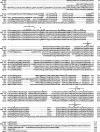Heterologous expression and characterization of CpI, OcpA, and novel serine-type carboxypeptidase OcpB from Aspergillus oryzae
- PMID: 19557408
- PMCID: PMC2773364
- DOI: 10.1007/s00253-009-2087-4
Heterologous expression and characterization of CpI, OcpA, and novel serine-type carboxypeptidase OcpB from Aspergillus oryzae
Abstract
In the genome of Aspergillus oryzae, 12 genes have been predicted to encode serine-type carboxypeptidases. However, the carboxypeptidase activities of the proteins encoded by these genes have not yet been confirmed experimentally. In this study, we have constructed three of these 12 genes overexpressing strains using Aspergillus nidulans and characterized their overproduced recombinant proteins. Of these three genes, one was previously named cpI; the other two have not been reported yet, and hence, we named them ocpA and ocpB. The recombinant proteins released amino acid residues from the C terminus of peptides, and the activity of the enzymes was inhibited by phenylmethylsulfonyl fluoride, indicating the enzymes to be serine-type carboxypeptidases. Recombinant OcpA, OcpB, and CpI were stable at 45 degrees C, 55 degrees C, and 55 degrees C, respectively, at a low pH. The enzymatic properties of recombinant OcpB were different from those of any reported serine-type carboxypeptidase. On the other hand, recombinant OcpA had similar enzymatic properties to A. oryzae carboxypeptidases O1 and O2. The DNA and N-terminal amino acid sequences of carboxypeptidases O1 and O2 from A. oryzae IAM2640 were similar to those of OcpA. Result of transcriptional analysis of ocpA, ocpB, and cpI suggest differences in transcriptional regulation between these genes.
Figures







Similar articles
-
Enzymatic properties of the recombinant serine-type carboxypeptidase OcpC, which is unique to Aspergillus oryzae.Biosci Biotechnol Biochem. 2011;75(4):662-8. doi: 10.1271/bbb.100749. Epub 2011 Apr 22. Biosci Biotechnol Biochem. 2011. PMID: 21512241
-
Molecular cloning of ocpO encoding carboxypeptidase O of Aspergillus oryzae IAM2640.Biosci Biotechnol Biochem. 2010;74(5):1000-6. doi: 10.1271/bbb.90863. Epub 2010 May 7. Biosci Biotechnol Biochem. 2010. PMID: 20460731
-
Purification, characterization, and heterologous expression in Fusarium venenatum of a novel serine carboxypeptidase from Aspergillus oryzae.Appl Environ Microbiol. 1999 Aug;65(8):3298-303. doi: 10.1128/AEM.65.8.3298-3303.1999. Appl Environ Microbiol. 1999. PMID: 10427010 Free PMC article.
-
Unique catalytic and molecular properties of hydrolases from Aspergillus used in Japanese bioindustries.Biosci Biotechnol Biochem. 2000 Apr;64(4):675-88. doi: 10.1271/bbb.64.675. Biosci Biotechnol Biochem. 2000. PMID: 10830477 Review.
-
Carboxypeptidases in disease: insights from peptidomic studies.Proteomics Clin Appl. 2014 Jun;8(5-6):327-37. doi: 10.1002/prca.201300090. Epub 2014 Mar 24. Proteomics Clin Appl. 2014. PMID: 24470285 Free PMC article. Review.
Cited by
-
Functional expression and characterization of a novel aminopeptidase B from Aspergillus niger in Pichia pastoris.3 Biotech. 2021 Aug;11(8):366. doi: 10.1007/s13205-021-02915-4. Epub 2021 Jul 6. 3 Biotech. 2021. PMID: 34290949 Free PMC article.
-
Improving rhamnolipids production using fermentation-foam fractionation coupling system: cell immobilization and waste frying oil emulsion.Bioprocess Biosyst Eng. 2023 Aug;46(8):1175-1194. doi: 10.1007/s00449-023-02890-5. Epub 2023 Jun 20. Bioprocess Biosyst Eng. 2023. PMID: 37338581
-
A new carboxypeptidase from Aspergillus niger with good thermostability, pH stability and broad substrate specificity.Sci Rep. 2021 Sep 21;11(1):18745. doi: 10.1038/s41598-021-98003-x. Sci Rep. 2021. PMID: 34548523 Free PMC article.
-
Serine-type carboxypeptidase KexA of Aspergillus oryzae has broader substrate specificity than Saccharomyces cerevisiae Kex1 and is required for normal hyphal growth and conidiation.Appl Environ Microbiol. 2012 Nov;78(22):8154-7. doi: 10.1128/AEM.01601-12. Epub 2012 Sep 7. Appl Environ Microbiol. 2012. PMID: 22961905 Free PMC article.
-
Genome sequence of Aspergillus luchuensis NBRC 4314.DNA Res. 2016 Dec;23(6):507-515. doi: 10.1093/dnares/dsw032. Epub 2016 Sep 20. DNA Res. 2016. PMID: 27651094 Free PMC article.
References
-
- Dal Degan F, Ribadeau-Dumas B, Breddam K. Purification and characterization of two serine-type carboxypeptidases from Aspergillus niger and their use in C-terminal sequencing of proteins and peptide synthesis. Appl Environ Microbiol. 1992;58:2144–2152. doi: 10.1128/AEM.58.7.2144-2152.1992. - DOI - PMC - PubMed
-
- Doan NP, Fincher GB. The A- and B-chains of carboxypeptidase I from germinated barley originate from a single precursor polypeptide. J Biol Chem. 1988;263:11106–11110. - PubMed
Publication types
MeSH terms
Substances
LinkOut - more resources
Full Text Sources

